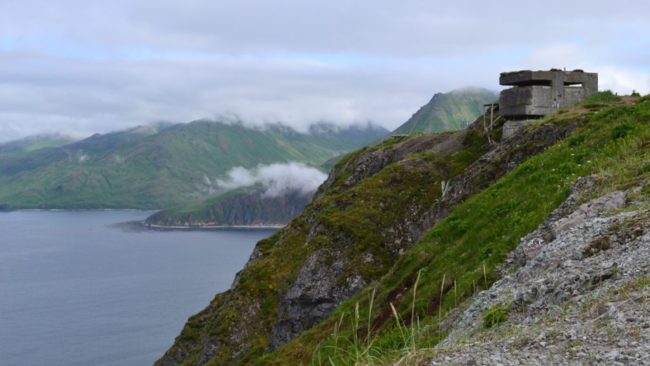Do You Want to See the Aleutians? by Poppy Benson, Vice President for Outreach
February 2024’s presentation on the Aleut prehistory of the Aleutian Islands, might get you thinking, I want to go there. So how? Yes, the Aleutians are remote and stormy with minimal transportation but it is possible to visit at least a part of this fabulous volcanic island chain of seabirds and seals, wild flowers and wind, ancient ways and WWII history. Nearly all of the Aleutians are in the Alaska Maritime National Wildlife Refuge.
Although there were hundreds of villages precontact there are only five now: Akutan, Unalaska, Nikolski, Atka and Adak, there are only 5 now. Each has some form of commercial air transportation, but it may not be often and can be unreliable due to weather. Dutch Harbor/Unalaska and Adak are the easiest to access.
Unalaska has it all: birds, whales, fish, culture, history, hiking, kayaking, volcanoes and fine accommodations. The ferry Tustumena makes a monthly 3 day trip from Homer stopping for a full day in Kodiak with a chance to visit the Kodiak Refuge and an afternoon in Cold Bay where Izembek Refuge staff may take you on a tour of refuge lands. Other village stops in Chignik Bay, Sand Point, King Cove and False Pass are brief but memorable. Unalaska is famous with birders as the easiest place to see the whiskered auklet, a bird found only in the Aleutians and adjacent Russian islands.
Unalaska is famous with birders as the easiest place to see the whiskered auklet, a bird found only in the Aleutians and adjacent Russian islands.
Give yourself time to experience Unalaska by staying a few days and flying back. A fine hotel, the Grand Aleutian, other lodging options and numerous restaurants make visiting comfortable. Local guides can take you birding or to WWII sites. Culture and history abound here with a historic Russian Orthodox Church, the Museum of the Aleutians, and the World War II Historic Site and Museum. Most of the island is in the refuge.
Adak, 450 miles farther out the chain, is a very different experience. Once a military base that was home to over 5000, only about 170 live there now. The abandoned, crumbling base would make a good set for a zombie movie. But the island boasts beaches, a lagoon packed with otters and Emperor geese, hiking trails, rare birds blown in from Asia, fishing and caribou and ptarmigan hunting. Constructed almost overnight during WWII, Adak was an important base right up to the 1990s. Alaska Air flies twice a week and mileage tickets can be cheap. Former military housing, now privately owned, can be rented but bring your food as shopping is minimal. The Alaska Maritime Refuge has a satellite office with a few exhibits. Bird companies lead tours to Adak for the fall and spring migration. 
Dutch Harbor, Unalaska’s port, is the number one fishing port in the US and the burly fishing fleet, popularized in the reality show Deadliest Catch, adds a unique element.
The small villages of Akutan, Nikolski and Atka are much harder to visit. Grant Aviation flies but weather can shut them down for days on end. Nikolski has a small lodge but in the other villages you need to speak to the village corporation to find out about housing. This would be quite an experience for the self-sufficient and culturally aware person.
To visit any of the other 70 plus islands in the chain you will have to find a boat. In some years, a cruise ship will pass through the chain visiting uninhabited islands. Search online because no company does it regularly. Attu, the holy grail of birding and WWII history, is nearly impossible to get to since the Coast Guard left in 2010 leaving the island uninhabited with no maintenance on the runway. Attu, the last island in the chain, was occupied by the Japanese and the site of a major WWII battle. A fascinating place but I just don’t think you can get there now. But visit what you can of this wildlife refuge so unique in wildlife, land forms and history.
